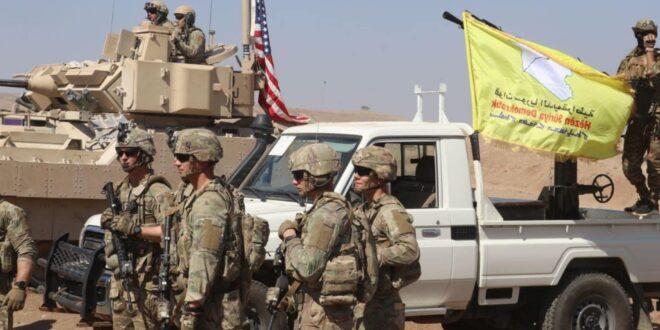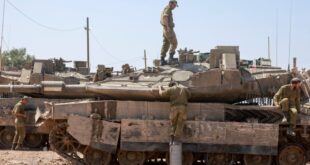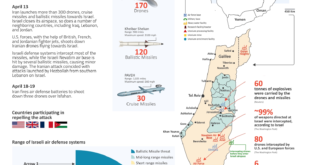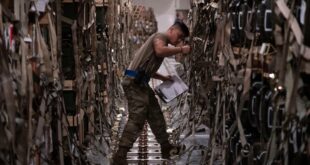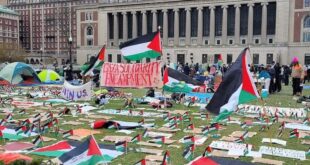Hardly had the echoes of the attack carried out by the Islamic State in the Russian capital, Moscow, in the early hours of March 23 resonated through the Russian streets, before the Autonomous Administration of North and East Syria (AANES) announced its condolences to the Russian government.
In the condolence telegram sent to Moscow, AANES referred to the counter-terrorism effort as a “necessary and important procedure, and a job that requires full and complete cooperation between all the forces that are keen on battling it and ending it.”
AANES forms the political umbrella for the Syrian Democratic Forces (SDF), which is the main ally of the US forces in Syria, and stands at the opposing end with Russia in Syria.
Close to the Russian military base on the western bank of the Euphrates River, north of Deir Ezzor, the SDF regularly engages in clashes and confrontations with the Syrian regime’s forces, supported by Russia, at the same time sharing military points in other cities and governorates.
The situation of alliances and enmity between the AANES and local and international parties related to the Syrian file is considered complex and unclear.
What are the determinants of AANES’ foreign policy?
The decision-making mechanism and political stance within AANES are subject to balances imposed by agendas and dictates from the leadership of the Democratic Union Party (PYD), which is organically influenced by the constraints imposed by the Kurdistan Workers’ Party (PKK), acknowledging some internal and external influences on these decisions, according to a study prepared by the Omran Center for Strategic Studies, published at the beginning of March.
The determinants of AANES in its convergence with the regime revolve around the necessity of securing gains that legitimize its de facto authority and to look for other options to face Turkish threats, it also reaches out to some opposition parties in an attempt to frame areas of joint action to mitigate its losses due to its absence in the official frameworks of the Syrian opposition.
The same study stated that Operation Peace Spring conducted by Turkey against the SDF in northern Syria significantly influenced AANES’ political behavior, as it opened up more to Russia and the regime. The operation also affected the consolidation of the “right-wing” trend within the Democratic Union Party associated with the PKK, at the expense of the “reformist stream” which tried to get closer to the West.
Russia’s active entry into eastern Syria after 2019 provided AANES with a new political card for negotiation, but it also forced it to make political and security concessions, while retaining a margin of political maneuver in its relations with Russia and Western countries.
Besides, the study saw that in addition to the structural gaps and barriers within the SDF, their project in general is linked to the future directions of the Syrian file—if the control of the center over the peripheries is strengthened, AANES will try to obtain minor gains from the regime and its supporters.
The possibility of moving the Syrian file forward presents an opportunity for it to present itself as a new partner, but it will not find regional and local acceptance, while the scenario of maintaining the status quo as it is likely prevails, hence AANES’ continuing efforts to consolidate the “de facto decentralization,” according to the study.
To face threats
A few days ago, the general commander of the SDF, Mazloum Abdi, spoke about three parties attacking the areas under his forces’ control in northeastern Syria, namely Turkey, the Syrian regime, and the Islamic State organization.
In a recorded statement on March 27, he added that Turkey continues to attack areas in northeastern Syria, while the Syrian regime and its allies “seek to undermine the stability of the region,” pointing to the “threat” of the Islamic State organization as a danger to the region.
The researcher at the Omran Center who published the study, Samer al-Ahmad, told Enab Baladi that AANES’ relationship with the Syrian regime is linked to strengthening its authority as a “de facto power,” but more importantly, is to seek solutions in the face of existential Turkish threats to it in northeastern Syria.
He considered that the armed confrontations that erupt between it and the Syrian regime in Deir Ezzor are limited and do not reflect a state of enmity between the two sides, and these might be confrontations at the level of local groups perhaps.
The researcher mentioned that the relationship between the SDF and the regime is a strategic one; AANES aims to develop it continuously and on a larger scale, but naturally, it adheres to the principle of “do not put all your eggs in one basket,” which pushes it to open up to the regime and the Russians, and aims to open channels with the Syrian opposition that can negotiate with it outside the official opposition platforms.
Al-Ahmad added that AANES’ absence from the Syrian opposition platforms, whether in the Negotiation Commission or the National Coalition for Syrian Revolutionary and Opposition Forces, drives it to search for new allies from opposition currents not affiliated with these platforms, looking for a way to legitimize its existence.
Are there any red lines?
AANES deals with the areas it controls as “gains” it has obtained over the past years, and it will not forsake them, a description that has been repeatedly presented by its officials from its founding until today.
At the beginning of this year, AANES issued a statement in which it commented on a Turkish military escalation that affected the region and lasted for over a week, calling through it for the region’s components to “unite and rally around their Autonomous Administration, to face all attempts aiming to strike at our achievements.”
The same term was used by Badran Jia Kurd at the beginning of 2023, when he was serving as the co-chair of the Foreign Relations Department in AANES, saying that it is necessary to develop strategic diplomatic work in the upcoming period to match the level of developments that AANES faces to perform the “historic tasks” entrusted to it, and to maintain the achievements.
The former co-chair of AANES, Abdul Hamid al-Mahbash, also spoke about the fate of AANES amidst negotiations with the regime concurrent with the threats of Turkish attacks, stating that “preserving the achievements of AANES is a red line.”
Researcher Samer al-Ahmad believes that the red lines of AANES are linked to the “existential threats” that hinder its goal of prolonging the life of its project as much as possible.
Based on the above, al-Ahmad said that AANES manages its alliances in a balanced manner, between its relations with the East and the West, and even with the regional countries (Arab countries or Iran).
He added that any improvements requested by a country/entity from AANES could be acceptable as long as they do not touch the “sovereign decision” of the SDF, which is connected to the autonomy of the Kurdistan Workers’ Party’s decision in Qandil mountains.
The researcher sees that AANES or the SDF always show a form of pragmatism, but they always collide with the centralized decision and reference of the Autonomous Administration that defines the nature of relationships, which is the Kurdistan Workers’ Party and its regional and international interests.
Despite the clear signs of openness of AANES to other countries or entities, they are always determined by the interests of the PKK.
 Eurasia Press & News
Eurasia Press & News
